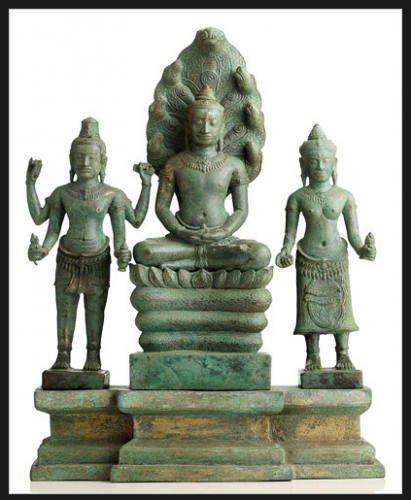
Between 1975 and 1979, during the brutal rule of the Khmer Rouge, the National Museum of Cambodia in Phnom Penh was severely damaged. According to the New York Times, “ purges wiped out much of its staff; its buildings, abandoned, were disintegrating. The art that didn’t disappear was severely damaged.” From the museum’s website:
The turmoil of recent decades has devastated all aspects of Cambodian life including the cultural realm. During the years of Khmer Rouge control the Museum, along with the rest of Phnom Penh, was evacuated and abandoned. The Museum suffered from neglect during this time and after the liberation of Phnom Penh on 7 January 1979 it was found in disrepair, its roof rotten, collection in disarray and garden overgrown. The Museum was quickly tidied up and reopened to the public on 13 April 1979. Tragically, however, many of the Museum’s employees had lost their lives during the Khmer Rouge regime. The resulting loss of expertise, combined with the deterioration of the Museum building and its collection, have made rehabilitation of the Museum a daunting task.
It is only within the last few years that the museum has been able to get back on its feet, thanks in large part to aid donated by institutions abroad. Freer and Sackler Galleries, with help from the Getty Foundation, helped to establish the Cambodian museum’s first metal-conservation laboratory, which allows for the preservation and study of the museum’s bronze sculpture. Now, thanks to the laboratory’s care, ancient Southeast Asian metal sculptures from the museum’s collection are currently on exhibition at the Arthur M. Sackler gallery at the Smithsonian in D.C. From the New York Times review of the exhibit:
This Sackler show — organized by Paul Jett, head of conservation at the Freer and Sackler, and Louise Allison Cort, curator of ceramics there — demonstrates some of the results of that care. It is also a reminder of how crucial is the search for fresh news from the past, a past that is every bit as much in flux as the present, and just as easy to miss if we’re not looking. For ancient art from Southeast Asia, we need every scrap of news we can get. Even the most basic facts elude us. We have no clear idea, for example, of when metal casting arrived in Cambodia, or where it came from when it did.
If you visit the exhibit, you may have a hard time distinguishing between Buddhist and Hindu artwork. The review goes on to say that in many cases, it’s hard to tell what’s Buddhist and what’s Hindu:
Visual distinctions between religions, like doctrinal differences, were often vague. This is true at the Sackler. One impressive 10th-century figure of a broad-shouldered, four-armed male deity could be either Hindu or Buddhist. We might be able to tell if we could see the symbols in his crown. But at some point his head was knocked off and lost, so we’ll never know.
Read Holland Cotter’s full review of the exhibit here. Read more about the history of the National Museum of Cambodia here.